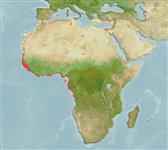>
Beloniformes (Needle fishes) >
Hemiramphidae (Halfbeaks)
Etymology: Hyporhamphus: Greek, hypo = under + Greek, rhamphos = beak, bill (Ref. 45335).
Eponymy: Monsieur Picart is said to have contributed natural history specimens from Cádiz, Spain, to the ‘King’s Cabinet’, but no further elaboration is made. (Ref. 128868), visit book page.
More on author: Valenciennes.
Environment: milieu / climate zone / depth range / distribution range
Ecología
marino; salobre bentopelágico; rango de profundidad 0 - ? m. Subtropical; 37°N - 9°S, 18°W - 36°E
Eastern Atlantic: West to Gibraltar, Morocco and Dakar, Senegal to Luanda, Angola. Eastern Mediterranean: From Lebanon and Israel.
Tamaño / Peso / Age
Maturity: Lm ? range ? - ? cm
Max length : 20.0 cm TL macho / no sexado; (Ref. 26999); common length : 15.0 cm TL macho / no sexado; (Ref. 26999)
Short description
Claves de identificación | Morfología | Morfometría
Espinas dorsales (total) : 0; Radios blandos dorsales (total) : 13 - 16; Espinas anales: 0; Radios blandos anales: 13 - 17. Diagnosis: body elongate; lower jaw forming long, narrow beak; upper jaw short, triangular and scaled; scales on snout; well developed preorbital crest between eye and nasal pit; pelvics fin abdominal; dorsal and anal fins placed far back on body and spineless; caudal fin slightly forked (Ref. 57227).
Occurs in coastal waters. Often enters estuaries (Ref. 2683). Live on or near the bottom where it feeds on algae and organic debris which it gathers from the surface of the sediment (Ref. 5377). Forms schools. Attracted to lights at night. Eggs are attached to aquatic vegetation by sticky threads (Ref. 6730).
Life cycle and mating behavior
Madurez | Reproducción | Puesta | Huevos | Fecundidad | Larva
Collette, B.B. and N.V. Parin, 1990. Hemiramphidae. p. 579-582. In J.C. Quero, J.C. Hureau, C. Karrer, A. Post and L. Saldanha (eds.) Check-list of the fishes of the eastern tropical Atlantic (CLOFETA). JNICT, Lisbon; SEI, Paris; and UNESCO, Paris. Vol. 2. (Ref. 4497)
IUCN Red List Status (Ref. 130435: Version 2024-1)
Threat to humans
Harmless
Human uses
Pesquerías: comercial
Herramientas
Special reports
Download XML
Fuentes de Internet
Estimates based on models
Preferred temperature (Ref.
123201): 18.4 - 27.9, mean 21.9 °C (based on 146 cells).
Phylogenetic diversity index (Ref.
82804): PD
50 = 0.5000 [Uniqueness, from 0.5 = low to 2.0 = high].
Bayesian length-weight: a=0.00257 (0.00115 - 0.00574), b=3.09 (2.91 - 3.27), in cm total length, based on LWR estimates for this Genus-body shape (Ref.
93245).
Nivel trófico (Ref.
69278): 2.0 ±0.00 se; based on food items.
Resiliencia (Ref.
120179): Alto, población duplicada en un tiempo mínimo inferior a 15 meses (Preliminary K or Fecundity.).
Fishing Vulnerability (Ref.
59153): Low vulnerability (10 of 100).
